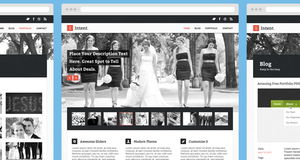关于体育的网站设计代码
Title: Crafting an Engaging Sports Website Design Template
Creating a captivating sports website design template requires a blend of aesthetic appeal, functionality, and user engagement tailored to the unique needs of sports enthusiasts. Here's a comprehensive guide on designing a dynamic sports website template that resonates with your audience:
1. Homepage:
Dynamic Hero Section:
Feature highresolution images or videos showcasing thrilling sports moments to instantly captivate visitors.
Upcoming Events Section:
Highlight upcoming games, matches, or tournaments with dates, times, and teams involved.
Featured Content:
Showcase popular articles, videos, or interviews to keep visitors engaged.
Social Media Integration:
Integrate social media feeds to foster community interaction and share realtime updates.2. Navigation:
Clear Menu Structure:
Organize categories logically (e.g., sports news, live scores, player profiles) for easy navigation.
Dropdown Menus:
Utilize dropdown menus for subcategories to streamline access to specific content.
Search Bar:
Implement a prominent search bar allowing users to find desired content swiftly.3. Live Scores Section:

RealTime Updates:
Provide live scorecards or tickers for ongoing matches across various sports.
Customization Options:
Allow users to personalize their feed by selecting favorite teams or leagues.4. News and Articles:
Featured Stories:
Highlight top news articles, analysis pieces, or editorials related to sports events.
Categorization:
Organize articles by sports type, leagues, or trending topics for easy browsing.
Multimedia Integration:
Incorporate images, videos, and infographics to enhance storytelling.5. Player Profiles:
Comprehensive Profiles:
Create detailed profiles of athletes, including biographies, career stats, and achievements.
Interactive Features:
Add interactive elements such as sliders for performance stats or timelines for career milestones.
Fan Engagement:
Allow fans to comment, share, or rate player profiles to encourage interaction.6. Multimedia Gallery:
Photo Galleries:
Curate galleries of highquality images capturing memorable sports moments.
Video Highlights:
Showcase video highlights of games, interviews, and behindthescenes footage.
UserGenerated Content:
Encourage users to submit their photos or videos for inclusion in the gallery.7. Community Features:
Forums or Discussion Boards:
Foster a sense of community by providing a platform for fans to discuss matches, players, and teams.
Fan Polls:
Conduct polls on trending topics or match predictions to engage visitors and gather feedback.
User Profiles:
Allow users to create profiles, follow other fans, and customize their experience.8. Responsive Design:
Mobile Optimization:
Ensure seamless functionality and intuitive navigation across devices of all sizes.
Fast Loading Times:
Optimize images and content to minimize load times, keeping users engaged and reducing bounce rates.9. Call to Action (CTA) Buttons:
Subscription Prompts:
Encourage visitors to subscribe to newsletters or push notifications for updates on their favorite sports.
Ticket Sales:
Direct users to purchase tickets for upcoming matches or events through strategic CTAs.10. Footer Section:
Contact Information:
Provide contact details for inquiries, feedback, or advertising opportunities.
Site Map:
Include a sitemap for easy navigation and improved SEO.
Social Media Links:
Link to your social media profiles for users to connect with your brand across platforms.Crafting an engaging sports website design template requires meticulous planning, incorporating elements that cater to the preferences and expectations of sports enthusiasts. By implementing these guidelines, you can create a visually stunning and functionally robust platform that keeps users coming back for more thrilling sports content.
欧洲杯直播
MORE>-
09-19加纳乔本赛季造球超过姆巴佩,近天进球和桑乔今年一样多
-
09-19制造胜率高达%,仅次于弗格森!滕哈格真是杯赛专家?
-
09-19孔帕尼三连胜:执教拜仁开启追求蓝图的新篇章
-
09-18破案了!国足换帅叫停原因找到,强赛计划有变,伊万阴谋得逞
-
09-18杨政回应未通过体测:早知道要体测就不参选已尽力否认嘲笑牟进宏
-
09-18贾巴里·史密斯:火箭的完美副手与宝贵特质
-
09-18不愧名帅!水庆霞近轮豪取分:击败女足卫冕冠军武汉!
-
09-18韩网评选世界赛阵容竟落选
-
09-17孙杨张豆豆晒合照送中秋祝福
-
09-16王楚钦输球是假球?许昕说实话了→
-
09-16阿塞拜疆正赛:皮亚斯特里夺冠,塞恩斯&佩雷兹退赛
-
09-16冠军战霸气完封波多黎各,日本棒球队世界杯夺冠,缔造连霸
-
09-15周六德甲:莱比锡红牛柏林联合
-
09-15全国田径锦标赛:谢震业迎奥运后首秀,秒小组第晋级
-
09-15准备现场督战,弗洛伦蒂诺率领皇马出征客场
-

2024今晚香港开特马开什么六期,答案解析解释落实掌握天下事_中级版33.291
在2024年的香港特马开奖活动中,众多彩民和观众都在关注着每一期...
-

2024年新澳门王中王资料,答案解析解释落实掌握天下事_3D6.3
在信息爆炸的时代,掌握最新的资讯成为了每个人不可或缺的能力。20...
-

最准一肖一码100%中,答案解析解释落实掌握天下事_辅助版2.11
在博弈领域,”最准一肖一码100%中”这一说...
-

黄雅琼黄凯祥分手事件解析
黄雅琼和黄凯祥是一对知名的明星情侣,他们的分手事件引起了广泛关注。在...
-

最准一肖一码100%香港78期,答案解析解释落实掌握天下事_平台版8.52
在当今信息爆炸的时代,人们对于获取准确信息的需求日益增长。特别是在博...
- 搜索
- 最近发表
-
- 曼城再创辉煌,欧冠新篇章开启,哈兰德金球梦触手可及
- 新赛季欧冠今晨开踢皇马拜仁利物浦等队首战告捷
- 场分钟!日本国脚在利物浦的挣扎与夏窗留队之惑
- 欧冠曼城国际米兰欧冠豪门对决!曼城誓斩国米,卫冕梦能否再燃战火?
- 新世纪巴萨失利最多的比赛是拉菲,皇马又何尝例外?
- 中国女排队长袁心玥已抵达瓦基弗银行俱乐部,开启留洋生涯
- 怒了米兰球迷赛后齐唱粗话抗议:把你们的蛋蛋拿出来!
- 有仇不报非君子🤣吕迪格庆祝时被队友围殴姆总左右开弓狂扇后脑
- 英格兰足球锦标赛
- 看个比赛欧洲杯要多少钱呢
- 辽宁体育篮球决赛
- 网络体育赌博黑钱吗
- 罗伊斯参加2024欧洲杯吗
- 皇马欧冠决赛输球
- 阿根廷vs乌拉圭世预赛
- 西班牙国民体育赛事
- 英国如何看欧洲杯比赛结果
- 英超什么时候开始新赛季
- 美洲杯欧洲杯哪个级别高
- 湖州师范体育特招
- 标签列表
-
- 2024年欧洲杯主办国 (17)
- 2024欧洲杯比赛时间 (20)
- 欧洲杯参赛球队有几支 (9)
- 2024欧洲杯百度百科 (21)
- 2024欧洲杯杯 (9)
- 2024年欧洲杯预选赛 (14)
- 2024年欧洲杯开幕时间 (10)
- 2024欧洲杯完整赛程表 (10)
- 2024欧洲杯主办城市 (17)
- 欧洲杯为什么没有中国 (13)
- 在哪里可以看欧洲杯预选赛 (11)
- 2024欧洲杯预选赛 (11)
- 欧洲杯在哪个国家举行2024 (12)
- 2024欧洲杯全部赛程 (10)
- 欧洲杯为什么没有直播 (15)
- 欧洲杯一共多少球队 (13)
- 欧洲杯历届冠军一览表 (10)
- 欧洲杯 (14)
- 欧洲杯赛程 (11)
- 直播吧官网 (10)
- 足球即时完整比分 (12)
- 2022年世界杯 (12)
- 直播8 (10)
- 直播吧 (21)
- 直播软件 (10)
